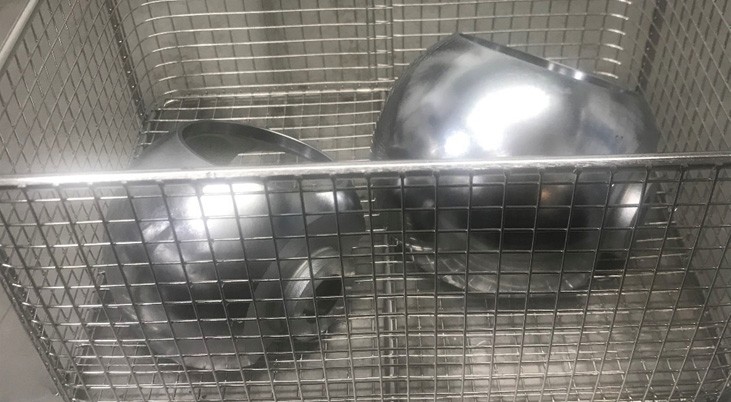
Uncategorized, Production, 02 December
Oxygen degreased valves: a critical safety measure
Oxygen degreased valves are essential for systems using pure oxygen, such as in medical equipment, aerospace applications, and chemical processes. Oxygen is a potent oxidizer and can react explosively with oils and greases. Therefore, it is crucial to remove all traces of these substances from valves and other components that come into contact with oxygen.
Risks of Inadequate Degreasing
Improper degreasing of valves can lead to serious risks, including:
- Explosions and Fires: Grease and oil can ignite in the presence of oxygen, leading to explosive reactions.
- Contamination: Residual contaminants can compromise the purity of oxygen, especially in medical settings where oxygen purity is critical.
- Corrosion: Impurities can cause corrosion of valve components, reducing their longevity and functionality.
Cryogenic Valves
Cryogenic valves are used in systems handling extremely low temperatures (below -150°C), such as in liquid nitrogen, helium, and other cryogenic liquids. Like oxygen degreased valves, cryogenic valves also require degreasing to avoid:
- Explosions and Fires: Grease and oil can combust in contact with cryogenic fluids, leading to hazardous conditions.
- Impaired Functionality: Contaminants can freeze, potentially blocking the valve and impacting system safety and efficiency.
When and How Degreasing Is Required
Degreasing is necessary in systems that use oxygen or cryogenic fluids, especially under high pressure or in pure form. The degreasing process typically includes the following steps:
- Initial Cleaning: Removing visible contamination using solvents or ultrasonic cleaning.
- Chemical Degreasing: Applying specific chemicals to dissolve and remove oils and greases.
- Drying: Thorough drying to ensure that no cleaning agent residue remains.
- Inspection: Visual and sometimes analytical inspections to ensure all contaminants have been removed.
Handling oxygen degreased valves and cryogenic valves
After degreasing, valves must be handled carefully to avoid recontamination:
- Storage: Valves should be stored in clean, tightly sealed packages.
- Installation: Clean gloves and tools should be used during installation to prevent introducing new contaminants.
- Maintenance: Regular inspections and maintenance ensure the valves remain clean and fully functional.
EIGA Doc 33/18: Cleaning Standards
The European Industrial Gas Association (EIGA) Doc 33/18 provides guidelines for cleaning equipment used in oxygen environments. The document outlines detailed procedures for removing contaminants such as oils, grease, dust, and other organic and inorganic materials from surfaces that may contact oxygen. This process is critical because oxygen is highly reactive and can cause combustion of materials that would not typically ignite in regular air conditions.
Cleaning Process
To ensure safety in oxygen environments, equipment must be thoroughly cleaned to eliminate the risk of fire or explosion. The EIGA Doc 33/18 cleaning methods include:
- Selecting the Cleaning Agent: The right cleaning agent must be chosen based on the type of contaminants and materials involved. Solvent-based systems are commonly used, with modern solvents like ProSolv®5408e being both effective and environmentally friendly.
- Cleaning Procedure: The component is immersed in a solvent to remove contaminants. Ultrasound may be used to clean complex components with hard-to-reach surfaces.
- Vapor Degreasing: This method involves cooling the component to a temperature below the boiling point of the solvent. The solvent vapor then condenses on the surface, removing contaminants without leaving residue.
- Cleanliness Check: After cleaning, components are tested to ensure they meet cleanliness standards, which may include surface sampling and analysis to confirm that no hazardous contaminants remain.
Standards Applied
Several international standards govern the degreasing of valves for oxygen and cryogenic applications, including:
- EIGA 33: Cleaning of Equipment for Oxygen Service
- ISO 15001: Specifications for Medical Equipment Used with Oxygen
- ASTM G93: Standard for Purity of Materials in Oxygen Systems
- CGA G-4.1: Guidelines for Cleaning Equipment for Oxygen Use
- EIGA Doc 147: Guidelines for Safe Practices in Cryogenic Air Separation
By adhering to these guidelines and standards, the safety and efficiency of oxygen and cryogenic systems can be maintained, preventing potentially catastrophic incidents.
Are your valves intended for oxygen or cryogenic media? We offer expert degreasing services to ensure safety and reliability. Contact us to learn more!
 Language
Language Swedish
Swedish English
English